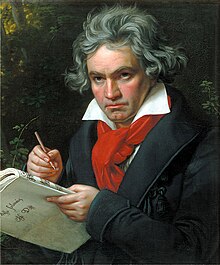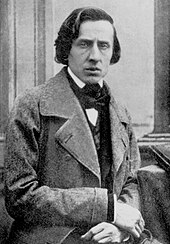Music Theory/Romantic
Basic Understanding
[edit | edit source]The 'Romantic' Period of music's history begins roughly in 1820 and ends no later than 1910.
All art (painting, music, drama etc.) during this period is considered to be of a 'Romantic' style. There is no supremely clear definition of this term, but one may consider it thus: A period in cultural history where art (and most notably music) began to grasp emotion and imaginative idea as its roots, rather than the heavily standardized rules and formulas of Classicism which had existed directly before - in the 18th century. Most specifically, and characteristic of even the early musical romantics, such as Beethoven, is the notion that a musical composition, on its own with no words sung, no operatic story it accompanies, but purely as music alone can convey an extramusical idea. Whether in Beethoven's entire 9th Symphony expressive of the values of freedom and equality of the post-American and French revolutions, or, the symphonic tone painting of Berlioz, extending even to the orchestral tone-poems of Richard Strauss (e.g., Don Quixote) Romantic Period music encapsulated ideas and emotions beyond the formal relationships of pitch, key, modulation or motivic structure and development alone.
Note: Donald Grout in The History of Western Music also mentions the alternation between Romantic and Classical eras throughout western music history.
The significance in this turning point in music's history cannot be underestimated. Calling it a revolution would be rather accurate. It was pioneered by a few individuals, not content with Classicism's standards, and caused nothing less than a paradigm shift in music's critical theory. Romanticism caused changes in how music was first conceived in a composer's mind, how it was performed and, of course, how it was received by an audience. Indeed, the full cycle of conception (by the composer) and reception (by the audience) became a much more organic axis around which music would develop from there on in.
Of course, music had never been composed without considering how it would be received (by definition, this is fundamentally impossible), but what Romanticism brought to this process was the new, now principal understanding of emotion. Thus, in the aforementioned cycle, this involves insertion of a composer's emotive/imaginative idea into a piece and the later reception of this emotion by an audience (these ideas would be developed vastly to the height of the impressionists in the early 20th Century). Therefore, Romanticism saw the arrival of music that was truly evocative. Music which was not simply technically fine-tuned and although extremely beautiful, lacking in that new experimental, revolutionary core that would fuel the ideas of Romanticists.
Ludwig van Beethoven
[edit | edit source]
It is my understanding that one individual in particular deserves - demands - special mention. He is Ludwig van Beethoven. Often credited with giving birth to Romanticism in its true sense in music, Beethoven is remembered as one who was often not content with conforming to Classicism's standardized understanding of music. Works by Beethoven that caused controversy when first performed became famous shortly after for being composed with brilliance and a revolutionary energy.
A perfect example is Beethoven's 3rd ('Eroica') Symphony. Although written initially in admiration of Napoleon Bonaparte, in whom Beethoven perceived great strength and heroism, upon Napoleon's crowning himself Emperor of France in 1804, one may see some of the fire in Beethoven upon learning that when he heard this news, Beethoven tore the title page of the Symphony (which held the dedication of the work to Napoleon on it) from the manuscript in fury - aghast at what Napoleon was doing.
The Symphony was later given the subtitle 'Eroica' in reference to a more general heroism and "composed to celebrate the memory of a great man". This seems to show Beethoven's wit - the Symphony remembers an earlier Napoleon, before he became - in Beethoven's mind - a tyrant.
The work was initially received with surprise and, now and again, shock from audiences who had not experienced a work of such length or power before. The music itself almost literally sparkles with brilliance. Beethoven has crafted a Symphony which began to give real definition to the word 'symphonic'. It is full of variety that had in reality never been seen before. It travels from lull to climax with such technical dexterity that it caused a handful of individuals in early audiences to swoon at its sheer power! Indeed, this is the core of the work. It rests on its ability to evoke emotion; it was designed to be a revolutionary work, a work that revelled in itself and most dazzlingly, in what Beethoven could create from an orchestra.
Beethoven had commented three years before embarking on the piece that he was unhappy with his work, that he would "henceforth (...) take a new path". It is no surprise therefore that many see the composition of Eroica as the first symphonic step for Beethoven that would bring Romanticism into music and change music history forever. One should also consider the Pathetique sonata which some believe is the single first piece that can be classed as part of Romanticism.
The Development of Romanticism
[edit | edit source]Beethoven, however, was just the beginning. Perhaps he is the most interesting as one can take his nine symphonies and listen to them in succession, hearing the unmistakable changes and developments he was bringing to music and symphonic form from the first to ninth work.
But romanticism continued strongly after Beethoven's death. Some of the most notable composers include Brahms, Dvořák, Tchaikovsky, Mendelssohn, Berlioz, Chopin, and Mahler. A few have been covered in further detail below.
Johannes Brahms
[edit | edit source]
A great admirer of Beethoven, Brahms was directly inspired by him and his first symphony was labelled 'Beethoven's Tenth' by admirers. Notable works include the 3rd Violin Sonata, the Violin concerto and his exceptional works for piano including the Intermezzos and Piano Concertos in particular. However, Brahms is often most famously remembered for his Hungarian Dances. This is an important facet in Romanticism - the use of folk melodies and traditional pieces in a symphonic setting was more or less new and became quite popular. Mahler (Symphonies) and Tchaikovsky (1st Piano concerto etc.) are great advocates of this along with Dvořák who wrote his 'Slavonic Dances' in 1878.
Antonín Dvořák
[edit | edit source]Another composer who drew direct inspiration from Beethoven, Dvořák wrote a number of extremely significant romantic works including his Cello and Violin Concertos. The former often being hailed as the greatest ever written. Although Czech, Dvořák spent time in America and pieces he wrote there (which included said Cello Concerto) offer insights into two feelings. Firstly his curiosity upon entering a different country (Symphony No.9, 'The New World' etc.) and secondly his feelings of homesickness (Folk melodies in the Cello Concerto and smaller violin works etc.).
Frédéric Chopin
[edit | edit source]
Polish-born composer Frédéric Chopin is most remembered for his works for Piano (Which include Preludes, Etudes, Waltzes, Mazurkas, Nocturnes, and Two Piano Concertos etc. etc.). Note in particular the (unofficially-) titled 'Revolutionary Etude', which is a startling piece of music which some believe was written in response to the 1831 Russian invasion of Warsaw.
Gustav Mahler
[edit | edit source]A late romantic, Mahler's latest works contain hints of impressionism. He was committed to evoking new emotions in audiences and presenting the world with new sounds and techniques from the orchestra. His compositional output is almost entirely Lieder (songs for voice and piano) and Symphonies. Where Brahms and Dvořák had taken Beethoven as the root for inspiration, Mahler (who was born in 1860) had a much wider variety of Romantics to draw on.
In particular, he is connected with Wagner and akin to the works of Bruckner. Mahler indeed pushed Romanticism to its limits, introducing some atonality to music, abundant use of scherzos and sonata forms and later, as stated, very early impressionism. It seems fitting that, although dying unfortunately young, Mahler died in 1911 - he had lived to the very edge of Romanticism; and briefly had the chance to peek beyond it.
Characteristics
[edit | edit source]- Emphasis on emotion
- Increased chromaticism and expansion of harmony
- New musical forms and expansion of old ones
- Expansion of the orchestra with new instruments
Above, I have selected the main factors from these composers that were major parts of Romanticism - they are the ideas and expressions that did not exist before and which gave true meaning to the word 'Romanticism'.
(The above is a brief beginning to this 'module' - I entreat its expansion and continued revision)
